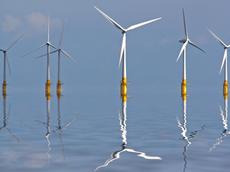Large wind turbines kinder to the environment
An ETH-Zurich study headed by Stefanie Hellweg, a professor of ecological systems design, concludes that large wind power plants produce greener electricity than smaller ones. The fact that the plant construction firms gain experience and learn from each other has a positive impact on the environment.

The sun, wind, and water are the hot topics of the hour. Renewable energies that will supply us with electricity in the future are in demand. Both consumers and electricity producers are building their hopes on wind power. But just how “ecological” are wind power plants if their entire life cycle is examined for CO2 emissions – from the energy input necessary to procure, process and transport building materials, to the use of energy to construct, operate, and demolish a plant.
A team of researchers from ETH Zurich and Radboud University Nijmegen in the Netherlands now provides new insights in an article that has just been published in Environmental Science & Technology: the larger the wind power plant, the greener the electricity it produces.
Learning experience pays off
“This results from a combination of plant size and learning effects,” says Marloes Caduff from the Institute of Environmental Engineering. “If you want to have a wind power plant with twice the output, it does not automatically mean you need twice the energy input and material to build it.” This so-called economy of scale is common in economics and can be applied to the environmental performance of wind power plants. Thus, it only costs marginally more energy to build a larger plant than a smaller one.
A wind power plant with a rotor diameter of ninety metres is thus considerably better off than one with a rotor diameter of sixty metres. For the large plant, not only does the global-warming potential for every kilowatt hour produced with wind power decrease; the production capacity also more than doubles.
Apart from anything else, wind energy from large plants is greener because the builders become more experienced and learn from each other. This accelerates progress in planning and constructing wind power plants. Consequently, the shape of the rotor blades could swiftly be optimised, which helps utilise the wind more effectively without increasing the size of the tower or generator unit.
For her case study, Marloes Caduff examined twelve individual wind turbines with rotors ranging from 12.5 to ninety metres in diameter. The CO2 emissions per kilowatt hour generated were known for these plants. The production of the steel masts is most harmful to the climate, responsible for almost forty per cent of a plant’s CO2 emissions, followed by the production of the generator unit (twelve to thirty-seven per cent). The fibreglass plastic for the rotors, chrome steel for the generator unit and foundation concrete also have a negative impact on the eco-balance.
In recent decades, not only has the number of wind turbines connected to the power grid grown, but the building dimensions have also become increasingly larger. In 1980 the rotor diameter was fifteen metres. Nowadays, there are plants with rotor diameters ten times as big, such as the offshore plant Alstom Aliade 150 off the coast of France. In addition, even bigger wind power plants are in the pipeline.
Gauging the impact of the generators on the environment
According to Caduff, the results of the study cannot be scaled up to larger wind turbines than the ones she has investigated. However, the data gained fromthis study would help plant operators to gauge the environmental impact of their own generators by being able to arrange them by diameter and height.
Wind power is a promising renewable energy source that is currently being promoted vigorously in many nations. Between 2006 and 2007 alone, the net wind energy production rose by over a fifth to 99,430 gigawatt hours (GWh) in the twenty-seven EU member states. Moreover, the USA has decided to cover a fifth of its electricity consumption with wind energy by 2030. In order to achieve this ambitious goal, however, more wind farms and larger wind turbines are needed.
Further reading
Caduff M, Huijbregts MAJ, Althaus H-J, Koehler A & Hellweg S. Wind Power Electricity: The Bigger the Turbine, the Greener the Electricity? Env Science&Techn. 2012, 46, 4725-4733. Doi: 10.1021/es204108n







READER COMMENTS